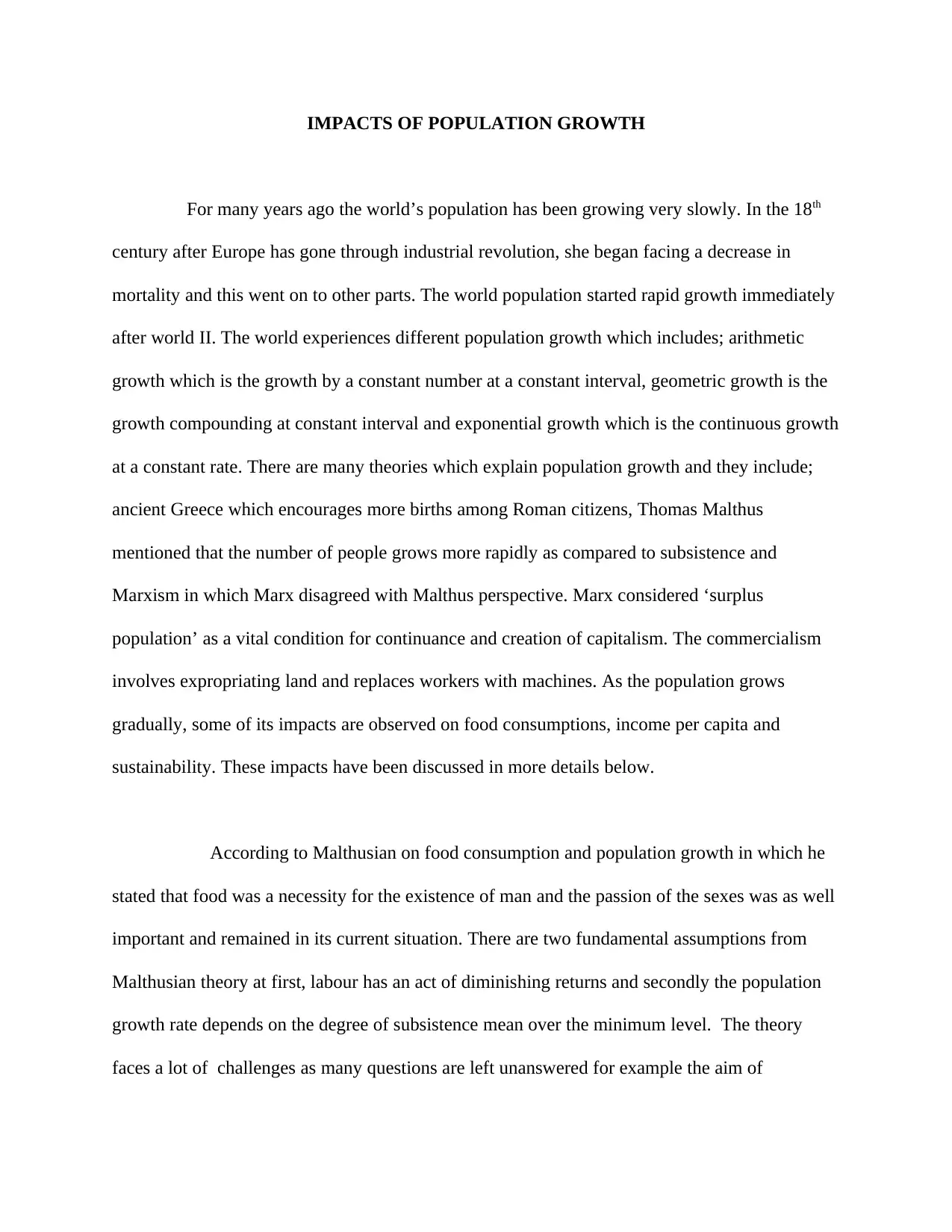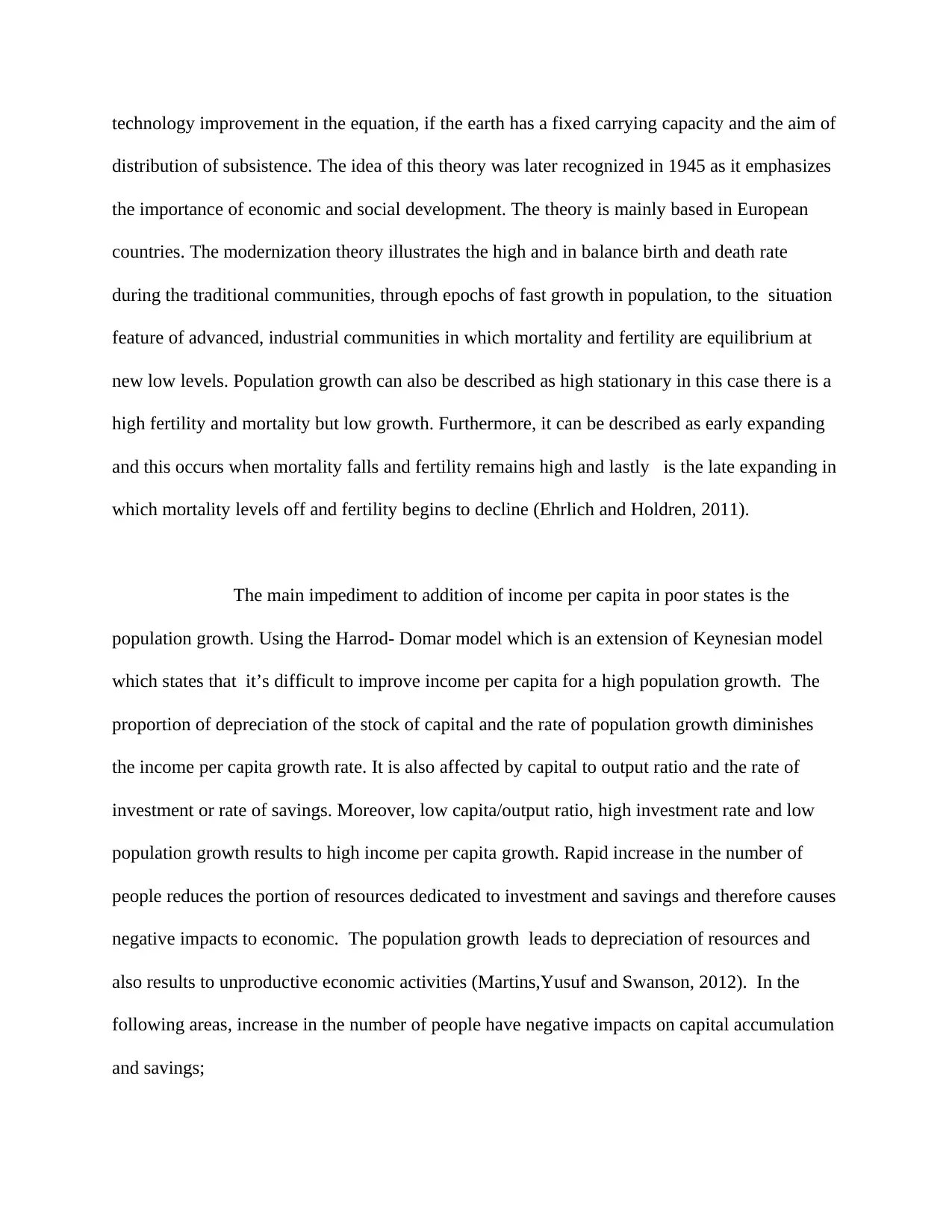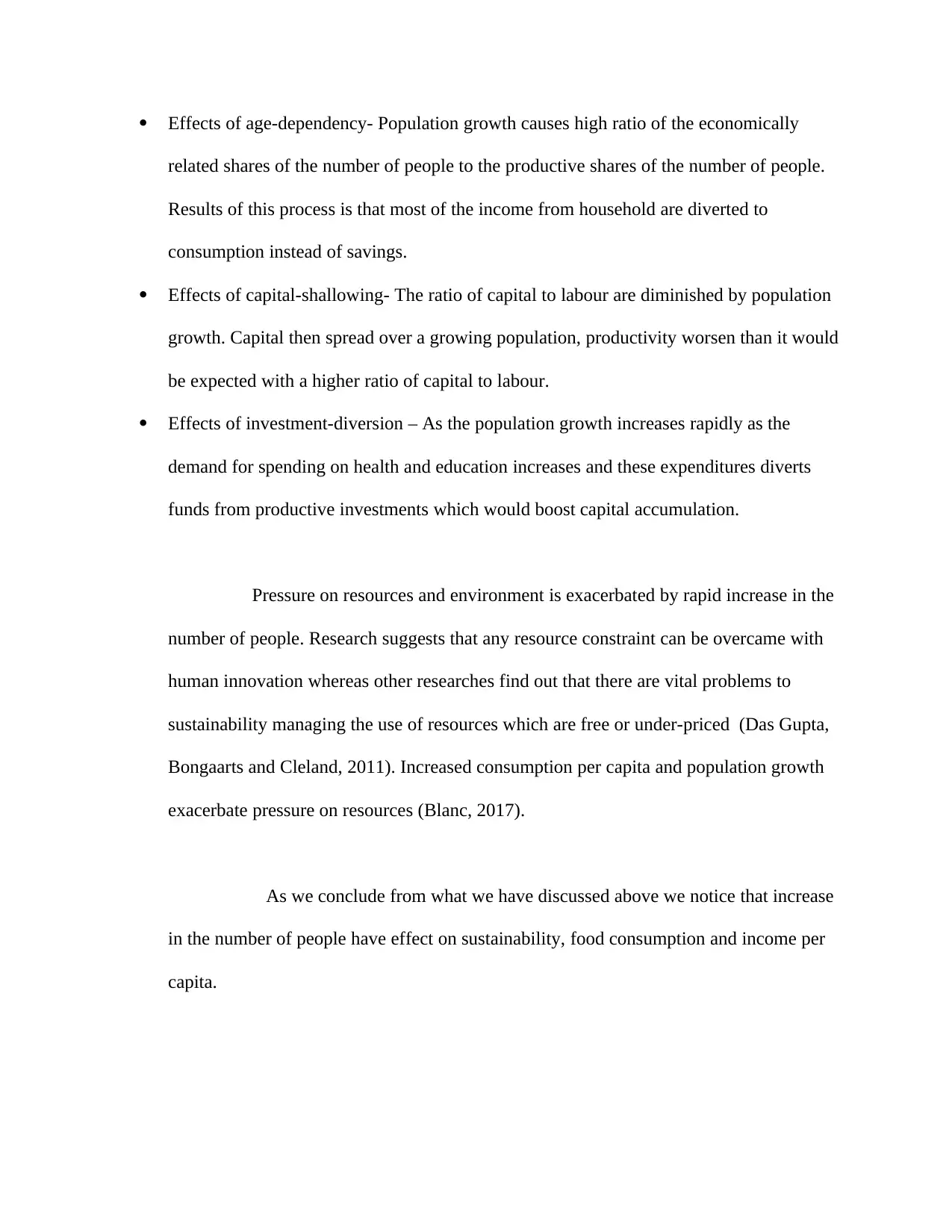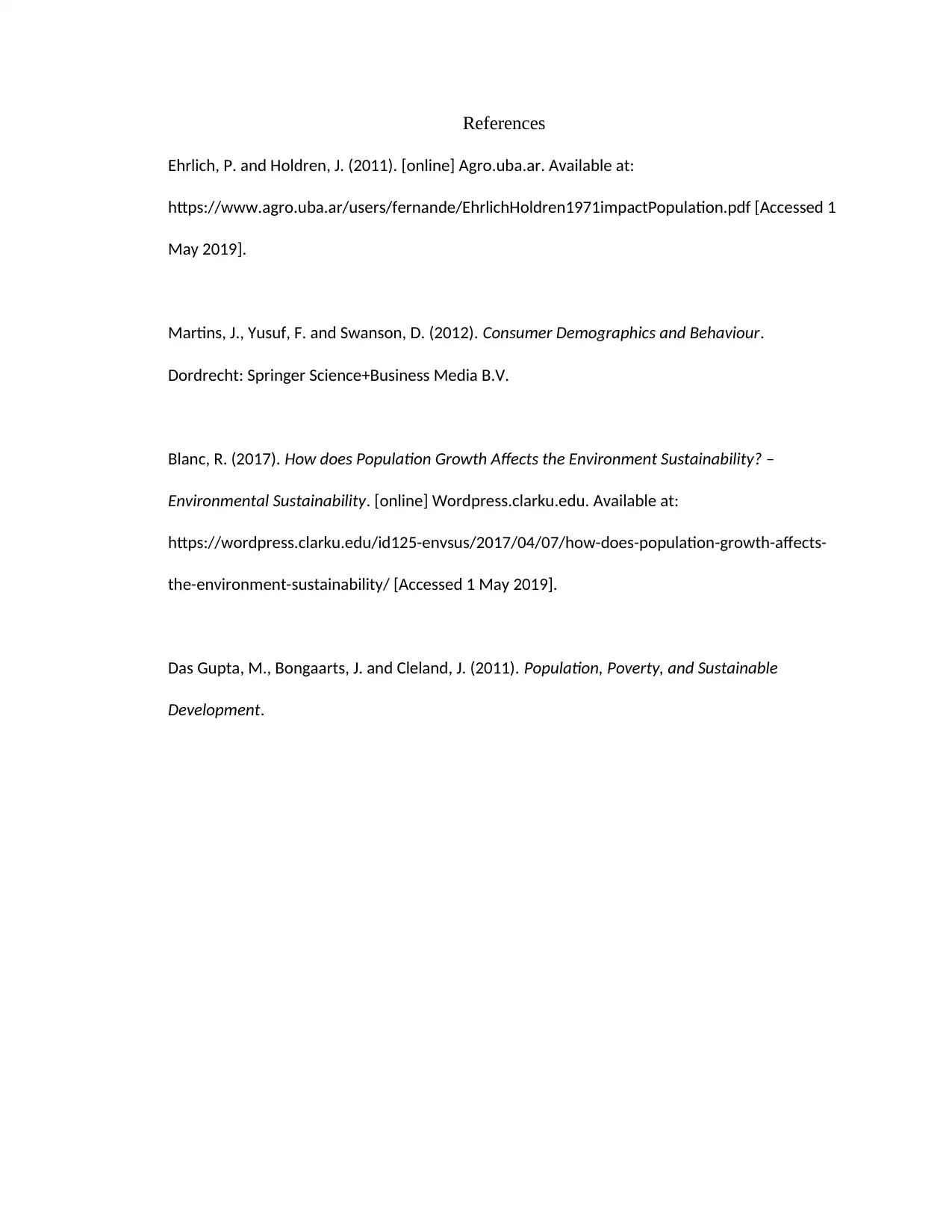Analyzing the Impacts of Population Growth on Food, Income Per Capita
VerifiedAdded on 2023/04/25
|4
|1001
|372
Essay
AI Summary
This essay examines the multifaceted impacts of population growth on food consumption, income per capita, and sustainability. It delves into various theories, including Malthusian perspectives, which highlight the relationship between population size and resource availability, particularly food. The analysis extends to the Harrod-Domar model, illustrating how rapid population growth can impede income per capita due to factors like age-dependency effects, capital-shallowing, and investment-diversion. The essay also addresses the environmental pressures exacerbated by increased consumption and population size, noting the debate between human innovation and resource constraints. Ultimately, the essay concludes that population growth significantly affects sustainability, food consumption patterns, and overall economic well-being, emphasizing the need for balanced development strategies.

IMPACTS OF POPULATION GROWTH
For many years ago the world’s population has been growing very slowly. In the 18th
century after Europe has gone through industrial revolution, she began facing a decrease in
mortality and this went on to other parts. The world population started rapid growth immediately
after world II. The world experiences different population growth which includes; arithmetic
growth which is the growth by a constant number at a constant interval, geometric growth is the
growth compounding at constant interval and exponential growth which is the continuous growth
at a constant rate. There are many theories which explain population growth and they include;
ancient Greece which encourages more births among Roman citizens, Thomas Malthus
mentioned that the number of people grows more rapidly as compared to subsistence and
Marxism in which Marx disagreed with Malthus perspective. Marx considered ‘surplus
population’ as a vital condition for continuance and creation of capitalism. The commercialism
involves expropriating land and replaces workers with machines. As the population grows
gradually, some of its impacts are observed on food consumptions, income per capita and
sustainability. These impacts have been discussed in more details below.
According to Malthusian on food consumption and population growth in which he
stated that food was a necessity for the existence of man and the passion of the sexes was as well
important and remained in its current situation. There are two fundamental assumptions from
Malthusian theory at first, labour has an act of diminishing returns and secondly the population
growth rate depends on the degree of subsistence mean over the minimum level. The theory
faces a lot of challenges as many questions are left unanswered for example the aim of
For many years ago the world’s population has been growing very slowly. In the 18th
century after Europe has gone through industrial revolution, she began facing a decrease in
mortality and this went on to other parts. The world population started rapid growth immediately
after world II. The world experiences different population growth which includes; arithmetic
growth which is the growth by a constant number at a constant interval, geometric growth is the
growth compounding at constant interval and exponential growth which is the continuous growth
at a constant rate. There are many theories which explain population growth and they include;
ancient Greece which encourages more births among Roman citizens, Thomas Malthus
mentioned that the number of people grows more rapidly as compared to subsistence and
Marxism in which Marx disagreed with Malthus perspective. Marx considered ‘surplus
population’ as a vital condition for continuance and creation of capitalism. The commercialism
involves expropriating land and replaces workers with machines. As the population grows
gradually, some of its impacts are observed on food consumptions, income per capita and
sustainability. These impacts have been discussed in more details below.
According to Malthusian on food consumption and population growth in which he
stated that food was a necessity for the existence of man and the passion of the sexes was as well
important and remained in its current situation. There are two fundamental assumptions from
Malthusian theory at first, labour has an act of diminishing returns and secondly the population
growth rate depends on the degree of subsistence mean over the minimum level. The theory
faces a lot of challenges as many questions are left unanswered for example the aim of
Paraphrase This Document
Need a fresh take? Get an instant paraphrase of this document with our AI Paraphraser

technology improvement in the equation, if the earth has a fixed carrying capacity and the aim of
distribution of subsistence. The idea of this theory was later recognized in 1945 as it emphasizes
the importance of economic and social development. The theory is mainly based in European
countries. The modernization theory illustrates the high and in balance birth and death rate
during the traditional communities, through epochs of fast growth in population, to the situation
feature of advanced, industrial communities in which mortality and fertility are equilibrium at
new low levels. Population growth can also be described as high stationary in this case there is a
high fertility and mortality but low growth. Furthermore, it can be described as early expanding
and this occurs when mortality falls and fertility remains high and lastly is the late expanding in
which mortality levels off and fertility begins to decline (Ehrlich and Holdren, 2011).
The main impediment to addition of income per capita in poor states is the
population growth. Using the Harrod- Domar model which is an extension of Keynesian model
which states that it’s difficult to improve income per capita for a high population growth. The
proportion of depreciation of the stock of capital and the rate of population growth diminishes
the income per capita growth rate. It is also affected by capital to output ratio and the rate of
investment or rate of savings. Moreover, low capita/output ratio, high investment rate and low
population growth results to high income per capita growth. Rapid increase in the number of
people reduces the portion of resources dedicated to investment and savings and therefore causes
negative impacts to economic. The population growth leads to depreciation of resources and
also results to unproductive economic activities (Martins,Yusuf and Swanson, 2012). In the
following areas, increase in the number of people have negative impacts on capital accumulation
and savings;
distribution of subsistence. The idea of this theory was later recognized in 1945 as it emphasizes
the importance of economic and social development. The theory is mainly based in European
countries. The modernization theory illustrates the high and in balance birth and death rate
during the traditional communities, through epochs of fast growth in population, to the situation
feature of advanced, industrial communities in which mortality and fertility are equilibrium at
new low levels. Population growth can also be described as high stationary in this case there is a
high fertility and mortality but low growth. Furthermore, it can be described as early expanding
and this occurs when mortality falls and fertility remains high and lastly is the late expanding in
which mortality levels off and fertility begins to decline (Ehrlich and Holdren, 2011).
The main impediment to addition of income per capita in poor states is the
population growth. Using the Harrod- Domar model which is an extension of Keynesian model
which states that it’s difficult to improve income per capita for a high population growth. The
proportion of depreciation of the stock of capital and the rate of population growth diminishes
the income per capita growth rate. It is also affected by capital to output ratio and the rate of
investment or rate of savings. Moreover, low capita/output ratio, high investment rate and low
population growth results to high income per capita growth. Rapid increase in the number of
people reduces the portion of resources dedicated to investment and savings and therefore causes
negative impacts to economic. The population growth leads to depreciation of resources and
also results to unproductive economic activities (Martins,Yusuf and Swanson, 2012). In the
following areas, increase in the number of people have negative impacts on capital accumulation
and savings;

Effects of age-dependency- Population growth causes high ratio of the economically
related shares of the number of people to the productive shares of the number of people.
Results of this process is that most of the income from household are diverted to
consumption instead of savings.
Effects of capital-shallowing- The ratio of capital to labour are diminished by population
growth. Capital then spread over a growing population, productivity worsen than it would
be expected with a higher ratio of capital to labour.
Effects of investment-diversion – As the population growth increases rapidly as the
demand for spending on health and education increases and these expenditures diverts
funds from productive investments which would boost capital accumulation.
Pressure on resources and environment is exacerbated by rapid increase in the
number of people. Research suggests that any resource constraint can be overcame with
human innovation whereas other researches find out that there are vital problems to
sustainability managing the use of resources which are free or under-priced (Das Gupta,
Bongaarts and Cleland, 2011). Increased consumption per capita and population growth
exacerbate pressure on resources (Blanc, 2017).
As we conclude from what we have discussed above we notice that increase
in the number of people have effect on sustainability, food consumption and income per
capita.
related shares of the number of people to the productive shares of the number of people.
Results of this process is that most of the income from household are diverted to
consumption instead of savings.
Effects of capital-shallowing- The ratio of capital to labour are diminished by population
growth. Capital then spread over a growing population, productivity worsen than it would
be expected with a higher ratio of capital to labour.
Effects of investment-diversion – As the population growth increases rapidly as the
demand for spending on health and education increases and these expenditures diverts
funds from productive investments which would boost capital accumulation.
Pressure on resources and environment is exacerbated by rapid increase in the
number of people. Research suggests that any resource constraint can be overcame with
human innovation whereas other researches find out that there are vital problems to
sustainability managing the use of resources which are free or under-priced (Das Gupta,
Bongaarts and Cleland, 2011). Increased consumption per capita and population growth
exacerbate pressure on resources (Blanc, 2017).
As we conclude from what we have discussed above we notice that increase
in the number of people have effect on sustainability, food consumption and income per
capita.
⊘ This is a preview!⊘
Do you want full access?
Subscribe today to unlock all pages.

Trusted by 1+ million students worldwide

References
Ehrlich, P. and Holdren, J. (2011). [online] Agro.uba.ar. Available at:
https://www.agro.uba.ar/users/fernande/EhrlichHoldren1971impactPopulation.pdf [Accessed 1
May 2019].
Martins, J., Yusuf, F. and Swanson, D. (2012). Consumer Demographics and Behaviour.
Dordrecht: Springer Science+Business Media B.V.
Blanc, R. (2017). How does Population Growth Affects the Environment Sustainability? –
Environmental Sustainability. [online] Wordpress.clarku.edu. Available at:
https://wordpress.clarku.edu/id125-envsus/2017/04/07/how-does-population-growth-affects-
the-environment-sustainability/ [Accessed 1 May 2019].
Das Gupta, M., Bongaarts, J. and Cleland, J. (2011). Population, Poverty, and Sustainable
Development.
Ehrlich, P. and Holdren, J. (2011). [online] Agro.uba.ar. Available at:
https://www.agro.uba.ar/users/fernande/EhrlichHoldren1971impactPopulation.pdf [Accessed 1
May 2019].
Martins, J., Yusuf, F. and Swanson, D. (2012). Consumer Demographics and Behaviour.
Dordrecht: Springer Science+Business Media B.V.
Blanc, R. (2017). How does Population Growth Affects the Environment Sustainability? –
Environmental Sustainability. [online] Wordpress.clarku.edu. Available at:
https://wordpress.clarku.edu/id125-envsus/2017/04/07/how-does-population-growth-affects-
the-environment-sustainability/ [Accessed 1 May 2019].
Das Gupta, M., Bongaarts, J. and Cleland, J. (2011). Population, Poverty, and Sustainable
Development.
1 out of 4
Related Documents
Your All-in-One AI-Powered Toolkit for Academic Success.
+13062052269
info@desklib.com
Available 24*7 on WhatsApp / Email
![[object Object]](/_next/static/media/star-bottom.7253800d.svg)
Unlock your academic potential
Copyright © 2020–2025 A2Z Services. All Rights Reserved. Developed and managed by ZUCOL.




